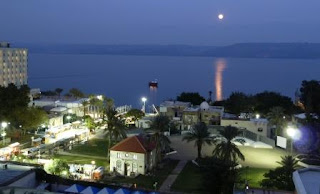 Tiberias is where we stayed for two nights during our excursions in the Galilee region. On the north-west side of Lake Galilee, Tiberias was established in 20 A.D. by Herod Antipas (Herod the Great's son), and named in honor of Tiberius Caesar. Besides the gorgeous view of the lake and the Golan Heights on the opposite shore, the emperor no doubt picked the spot for its famous mineral springs, which are still in use today.
Tiberias is where we stayed for two nights during our excursions in the Galilee region. On the north-west side of Lake Galilee, Tiberias was established in 20 A.D. by Herod Antipas (Herod the Great's son), and named in honor of Tiberius Caesar. Besides the gorgeous view of the lake and the Golan Heights on the opposite shore, the emperor no doubt picked the spot for its famous mineral springs, which are still in use today. Mentioned in the New Testament only once (John 6:23), the prominence of the city meant the Sea of Galilee was also known as the Sea of Tiberias (John 6:1; 21:1). It is very close to the region where Jesus carried out much of his ministry.
Mentioned in the New Testament only once (John 6:23), the prominence of the city meant the Sea of Galilee was also known as the Sea of Tiberias (John 6:1; 21:1). It is very close to the region where Jesus carried out much of his ministry.  It's a beautiful city as this shot from our boat ride on the lake shows. From the 2nd-10th centuries, it became the largest Jewish city in the Galilee region, and the most important one for Judaism on many levels. After the destruction of Jerusalem in 70 A.D., the Sanhedrin (highest legal body in Judaism) took up residence in Tiberias around 150 A.D. In the Middle Ages, Tiberias was the site of the great Jewish scribal school known as the Massoretes who were scrupulously careful in their copying of the Scriptures and produced the Massoretic Text, which is the foundational text for our modern Old Testament Scriptures. In addition to copying the text with great reverence and care, the scribes standardized Hebrew vowel points (Hebrew orginally was just consonants) and produced the Mishnah (Jewish rabbinal law) and Jerusalem Talmud here.
It's a beautiful city as this shot from our boat ride on the lake shows. From the 2nd-10th centuries, it became the largest Jewish city in the Galilee region, and the most important one for Judaism on many levels. After the destruction of Jerusalem in 70 A.D., the Sanhedrin (highest legal body in Judaism) took up residence in Tiberias around 150 A.D. In the Middle Ages, Tiberias was the site of the great Jewish scribal school known as the Massoretes who were scrupulously careful in their copying of the Scriptures and produced the Massoretic Text, which is the foundational text for our modern Old Testament Scriptures. In addition to copying the text with great reverence and care, the scribes standardized Hebrew vowel points (Hebrew orginally was just consonants) and produced the Mishnah (Jewish rabbinal law) and Jerusalem Talmud here.
No comments:
Post a Comment